Collectors' help
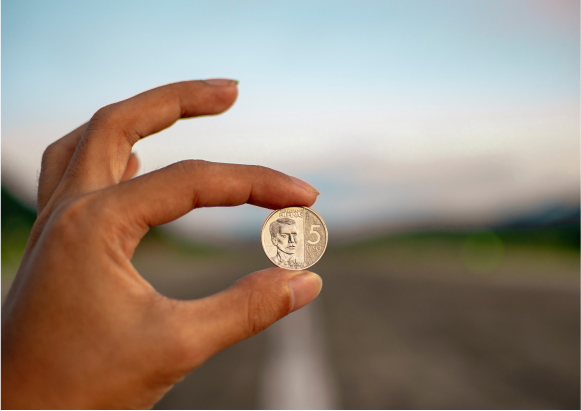
The reflection of history in every coin
Find out for yourself the history of each coin and the timeless ideas and values it expresses. From the Greek Revolution to the collection of Olympian Gods.
Order instantly in 3 simple steps



Coin order forms
Frequently Asked Questions
How can you acquire collector and commemorative euro coins?
Ι. TERMS AND CONDITIONS GOVERNING THE SALE OF COLLECTOR AND COMMEMORATIVE COIN SERIES
Sales of the above products to taxable persons established in another EU Member State shall be exempt from VAT, in accordance with the provisions of Article 28 of the VAT Code. Such exemption is subject to VAT validation through the VIES system and to proof of dispatch of the goods to the purchaser’s Member State of establishment.
By decision of the Minister of Economy and Finance, the Bank of Greece is authorised, through its Head Office and Branches, to sell collector and commemorative coin series issued following a joint decision of the Minister of Economy and Finance and the Governor of the Bank of Greece. The maximum allowed quantities are indicated in the first page of the preregistration form.
Detailed information regarding the sale of the numismatic products to any interested party (private collector – merchant) are posted on DIAVGEIA as well as on the official website of the Ministry of Economy and Finance (www.minfin.gr). Further information can be provided to any interested party by the relevant department of Ministry of Economy and Finance, namely the E Capital Transfers & Numismatic Issues Department of the State Guarantees & Capital Transfers Directorate, at the below referred telephone numbers: +30 210 3338 554, 210 3338 516 & 210 3338 513 and the following e-mail address: d25e@glk.gr.
For the purchase of quantities within the limits specified above, the following procedure shall apply:
ΙΙ. EMAIL ORDERING PROCEDURE FOR SMALL QUANTITIES OF COLLECTOR AND COMMEMORATIVE COIN SERIES
- Application submission
- First, the interested collectors shall fill out a Pre-Registration Form ( with all the necessary fields) and email it to serv.NumProdRetailDi@bankofgreece.gr and the merchants/traders to serv.NumProdWholDist@bankofgreece.gr. Upon receiving the form, the relevant unit of the Bank of Greece shall verify that the items requested are still in stock and enter the details of the order into its pre-registration/order database. The above referred unit of the Bank of Greece shall provide the below referred info to the applicant: (a) the Reference Number; (b) indication of any non-availability of the items requested; and (c) the total amount payable by the applicant.
- In order to finalise the ordering procedure, the applicant will then have to prepay the full amount of the order, within a deadline of three working days (starting from the Date of Pre-Registration). Otherwise, the order shall be cancelled.
- Payment of the total amount due (for finalization of the order):
The amount can can be made as follows:
- By money transfer (from a bank in Greece or abroad) to Bank of Greece Account No. GR4101004860000000059134368 – SALE OF COMMEMORATIVE COINS – BIC: BNGRGRAA. Important note: Field 70 of the money transfer order must mention the Reference Number and Date of Pre-Registration provided by the Bank of Greece to the applicant, as well as the applicant’s full name. Without this information, the Bank of Greece will not be able to match the money transfer to the corresponding pre-registration application and will not complete the procedure.
- At the counters of the Bank of Greece (Head Office or Branches): the applicant or a person authorised to act on his/her behalf can, upon presentation of valid identification (ID or passport), pay the amount quoted in the Pre-Registration Form.
- Dispatch of commemorative / collector coins to recipients
- Orders submitted by recipients residing within or outside Greece shall be carried out exclusively via a courier company authorised by the customer.
- It is noted that granted applications through e-mail orders cannot be picked up by the Head Office of the Bank of Greece. As long as quantity limitations apply, multiple applications with the same recipient shall not be accepted.
- In case that a remote order applicant for a numismatic product is found to have already purchased the certain product by the Head Office or any Branch of Bank of Greece, the remote order will be automatically cancelled and any such fee deposited will be returned to the applicant reduced by the money transfer fees. The above referred action will take place only when quantity limitations apply.
Commemorative euro coins
The introduction of euro coins in January 2002 has generated a variety of coin designs, since the euro area countries have put euro coins in circulation with distinctive national symbols on the common side, in addition to the differences on the national side.
The diversity of the coins' national sides is enhanced with the issuance of commemorative and collector coins, officially issued by the member states.
Their characteristic is that they have different national side than the common coins and are issued in order to celebrate events or commemorate anniversaries, honor a person etc. The common appearance, their characteristics and features are no different than the ones of a ordinary 2€ coin. Commemorative coins issued jointly by all countries of the euro area, have the same design on their national side, while the name of the issuing country and the celebrated event are written in the respective language.
Collector euro coins
Collector euro coins are officially issued by euro area countries, but are not intended for circulation. Their nominal value and designs are always different than the one of the coins in circulation.
While euro circulation coins are legal tender throughout the euro area, euro collector coins are legal tender only in their country of issuance. These coins are rarely used for payment purposes, because their market value is usually much higher than their nominal value and many of them are made out of precious metals such as gold or silver.
To avoid causing confusion to the public, the technical specifications of collector coins are different from those of circulation coins. Out of the three technical parameters, namely color, diameter and weight, at least two need to be different from those of euro circulation coins.
What are the characteristics of euro circulation coins?
Euro coins, in contrast with euro banknotes that have single appearance, have only one side that is common for all member states of the euro area. The national side bares representations selected from the competent authorities of each member-state. Regardless of the representation on the national side, the euro coins can be used as legal tender in all euro area member states.
Special features have been incorporated in order to facilitate blind and partially sighted persons.
One euro is divided in 100 cents. There are eight euro coin denominations:
| 1 cent | Diameter (mm): 16,25 Thickness (mm.): 1,67 Weight (g): 2,30 Shape: round Color: copper Composition: Copper-covered steel Edge: smooth |
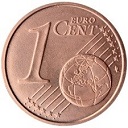 |
| 2 cent | Diameter (mm): 18,75 Thickness (mm.): 1,67 Weight (g): 3,06 Shape: round Color: copper Composition: Copper-covered steel Edge: Smooth with a groove |
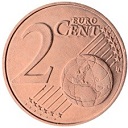 |
| 5 cent | Diameter (mm): 21,25 Thickness (mm.): 1,67 Weight (g): 3,92 Shape: round Color: copper Composition: Copper-covered steel Edge: smooth |
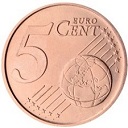 |
| 10 cent | Diameter (mm): 19,75 Thickness (mm.): 1,93 Weight (g): 4,10 Shape: round Color: gold Composition: Nordic gold Edge: Shaped edge with fine scallops |
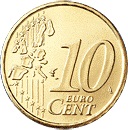 |
| 20 cent | Diameter (mm): 22,25 Thickness (mm.): 2,14 Weight (g): 5,74 Shape: Spanish flower shape Color: gold Composition: Nordic gold Edge: plain |
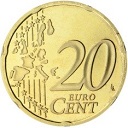 |
| 50 cent | Diameter (mm): 24,25 Thickness (mm.): 2,38 Weight (g): 7,80 Shape: round Color: gold Composition: Nordic gold Edge: Shaped edge with fine scallops |
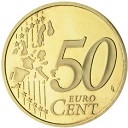 |
| 1 euro | Diameter (mm): 23,25 Thickness (mm.): 2,33 Weight (g): 7,50 Shape: round Color: Outer part: gold; inner part: silver Composition: Outer part: nickel brass; inner part: three layers: copper-nickel, nickel, copper-nickel Edge: Interrupted milled |
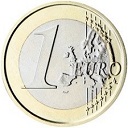 |
| 2 euro | Diameter (mm): 25,75 Thickness (mm.): 2,20 Weight (g): 8,50 Shape: round Color: Outer part: Silver; inner part: gold Composition: Outer part: copper-nickel; inner part: three layers: nickel brass, nickel, nickel brass Edge: Edge lettering, fine milled |
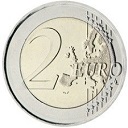 |
The Common side of euro coins
For the design of the common side of euro coins a competition was launched at European level. The winning series were designed by Luc Luycx of the Royal Belgian Mint.
After the EU enlargement of May 1, 2004 with 10 new member states, it was deemed necessary to change the common sides of the 10-, 20- and 50-cent and €1 and €2 coins, in order to represent the new composition of the EU. The related decision was taken by the European Council on 7 June 2005.
Member states have been issuing coins with the new common sides, gradually from 2007 onwards. The new member states that adopted the euro from 2007 onwards (Slovakia, Cyprus, Malta and Slovenia) minted coins with the new common sides. 1-, 2- and 5-cent coins show the denomination, the inscription "EURO CENT", six lines and twelve stars near the edge of the lines. The middle part of the lines shows Europe in relief in relation to Africa and Asia on a globe.
10-, 20- and 50-cent coins show the denomination, the inscription "EURO CENT", six vertical straight lines and twelve stars near the edge of each line. The upper middle part of the lines shows either the European Union with the 15 Member States before the enlargement of 1 May 2004 or a geographical image of Europe as of 1 January 2007.
€1 and €2 coins show the denomination, the inscription "EURO", six vertical lines and twelve stars near the edge of each line. The right part shows either the European Union before the enlargement of 1 May 2004 or a geographical image of Europe as of 1 January 2007.


